This week, we’re riding the wave of excitement with a spotlight on surfing, a thrilling water sport that combines physical skill, outdoor adventure, and a strong connection to the ocean. Whether you’re a beginner learning the basics or someone who’s been surfing for years, the experience offers something unique every time you head out.
Surfing challenges your body with paddling, balance, and timing, while also encouraging focus and adaptability as you learn to move with the changing conditions of the sea. It’s a great way to get active, enjoy fresh air, and take in the natural beauty of the coast.
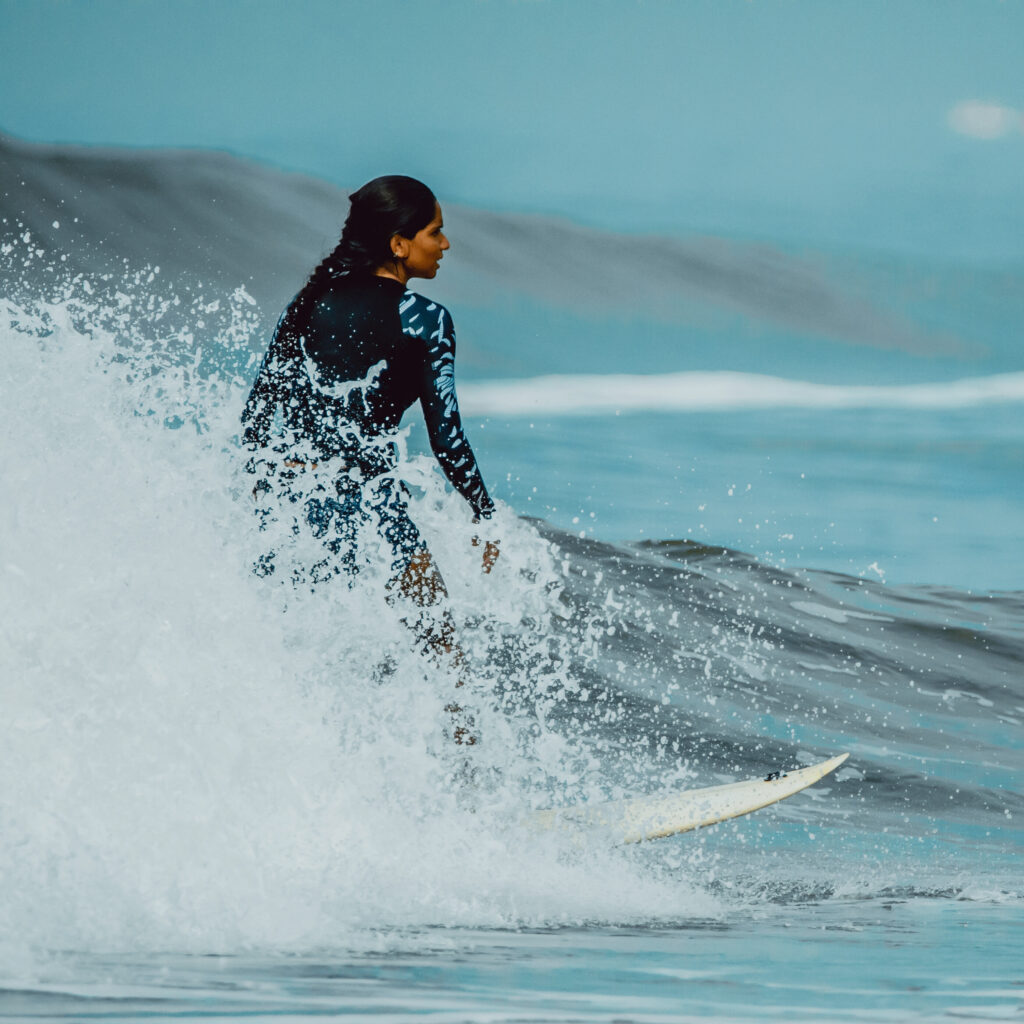
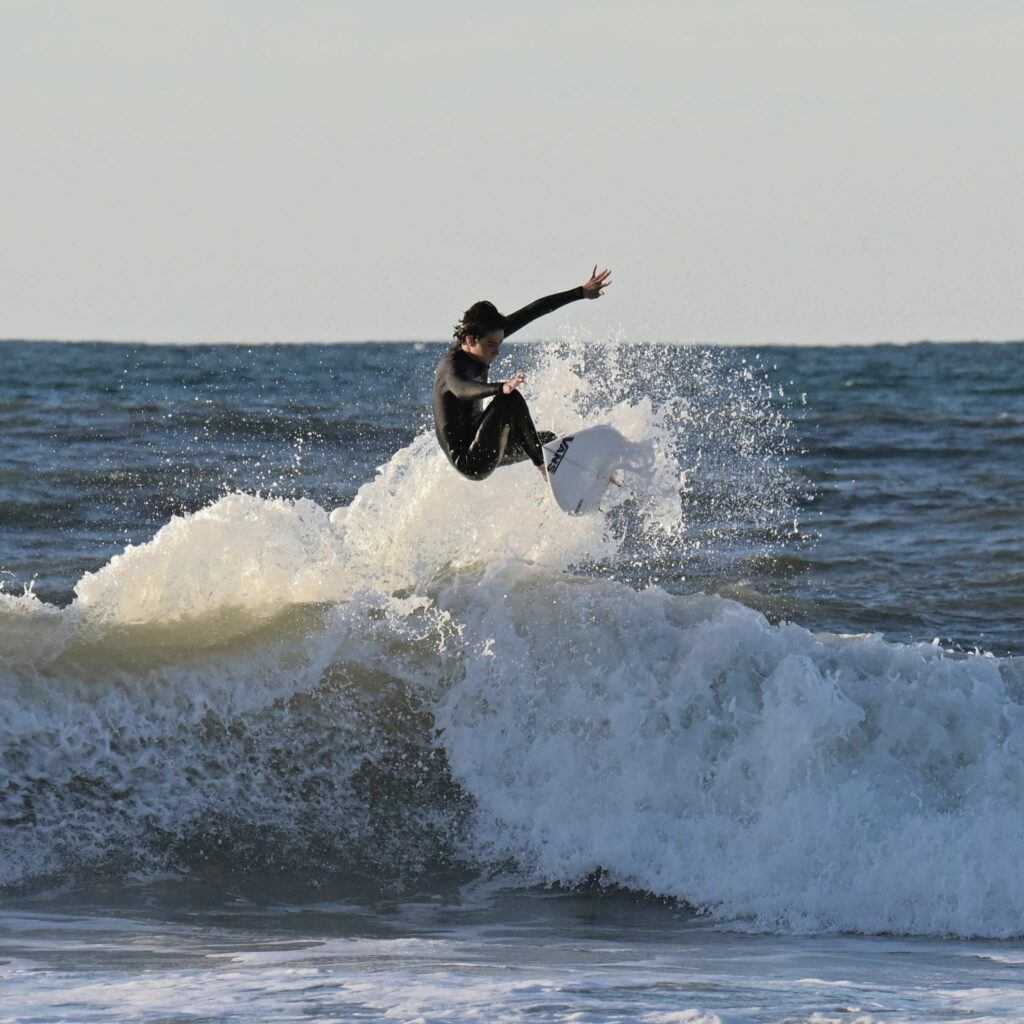

For some, it’s about the thrill of catching a wave. For others, it’s the peaceful rhythm of the paddle or the satisfaction of improving over time. However you approach it, surfing is an energizing and rewarding activity that offers both fun and growth—one wave at a time.
Surfing Description
Surfing is a surface water sport that involves riding ocean waves using a surfboard. The goal is to glide across the face of a wave as it breaks toward the shore.
While experienced surfers typically ride standing up, beginners often start by lying or kneeling on the board to build control and confidence before learning the standard pop-up technique of transitioning from prone to standing in one fluid motion.
A typical surf session begins with paddling out through the surf zone to reach the lineup, the area where waves begin to form.

Surfers wait for a suitable wave, then paddle hard to catch it, aiming to match the wave’s speed. Once the wave lifts the board, the surfer quickly pops up to a standing position and uses shifting body weight and foot placement to steer and maintain balance.

Wave types, breaks, and swell direction all influence how and where a wave can be ridden, making situational awareness a key part of the activity.
Surfboards vary in length, shape, and design depending on skill level and wave conditions.
Beginners often use soft-top longboards for greater stability, while advanced surfers might prefer shortboards for increased maneuverability.
Successful surfing requires coordination, timing, and an understanding of wave behavior, making it both a physical and technical activity.
Surfers must also develop an awareness of ocean conditions, including tides, currents, and wave sets, which can change rapidly and impact both safety and performance.
Understanding how to read the water, identifying rip currents or knowing where a wave is likely to break, is an essential part of becoming a confident surfer. With time and practice, these skills become intuitive, turning each session into a dynamic experience that builds a natural rhythm between the surfer and the waves.
Benefits of Surfing
Surfing offers a dynamic, full-body workout that combines cardiovascular endurance, strength training, and muscle control. Each paddle engages your shoulders, arms, and back, helping build upper body strength and stamina.
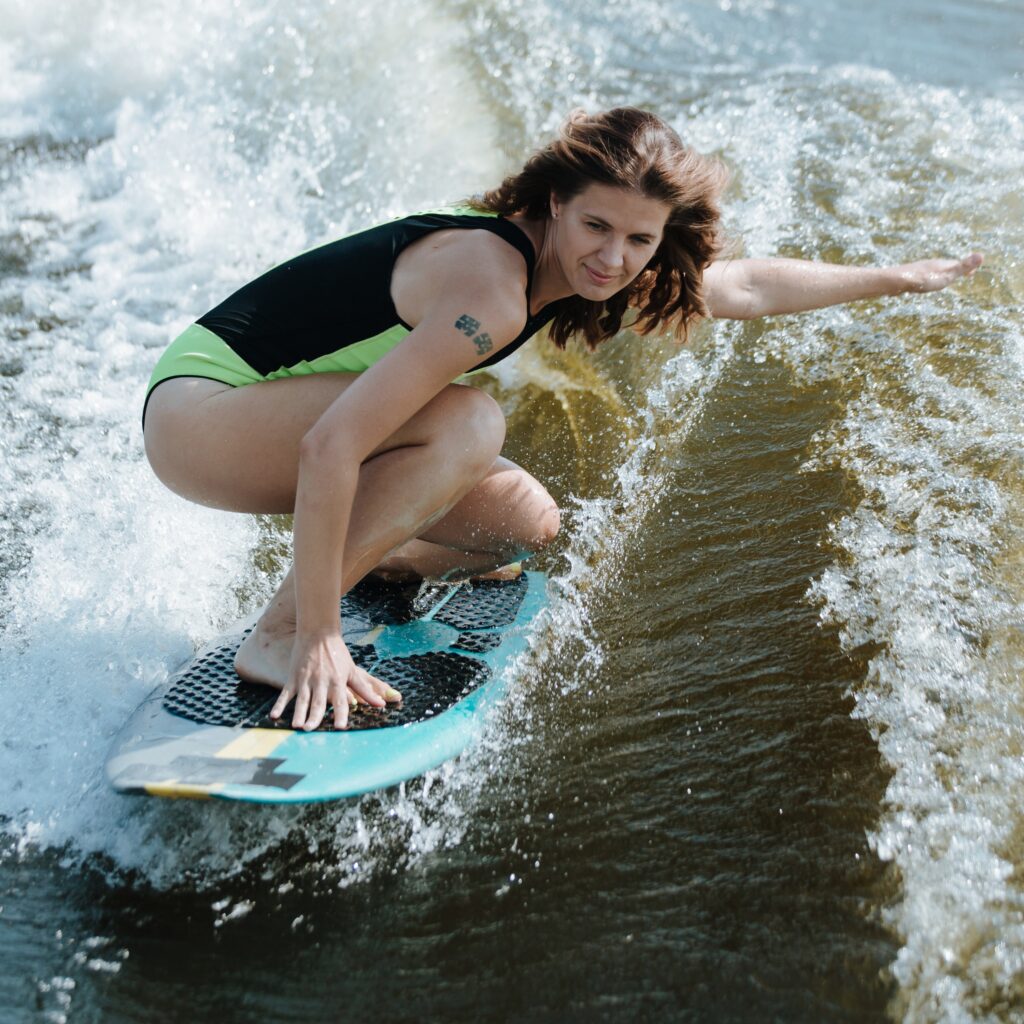
Balancing on the board activates your core and stabilizing muscles in your legs, improving coordination, flexibility, and overall physical performance.
It’s a total-body effort that builds both power and finesse over time.
Surfing also cultivates resilience, patience, and adaptability. It’s a sport shaped by nature, no two waves are the same, and progress comes with persistence. Wipeouts, missed waves, and long waits are all part of the process.
Learning to stay calm, reset, and try again builds mental strength and flexibility, qualities that extend far beyond the surf zone and into everyday challenges.
Connection is another key benefit. While surfing can be a solo endeavor, it’s also deeply communal. Many surfers form bonds through shared dawn patrols, beach meetups, and the unspoken etiquette of the lineup.
This spirit of mutual respect, support, and shared joy fosters friendships and a broader sense of belonging within the surf culture.
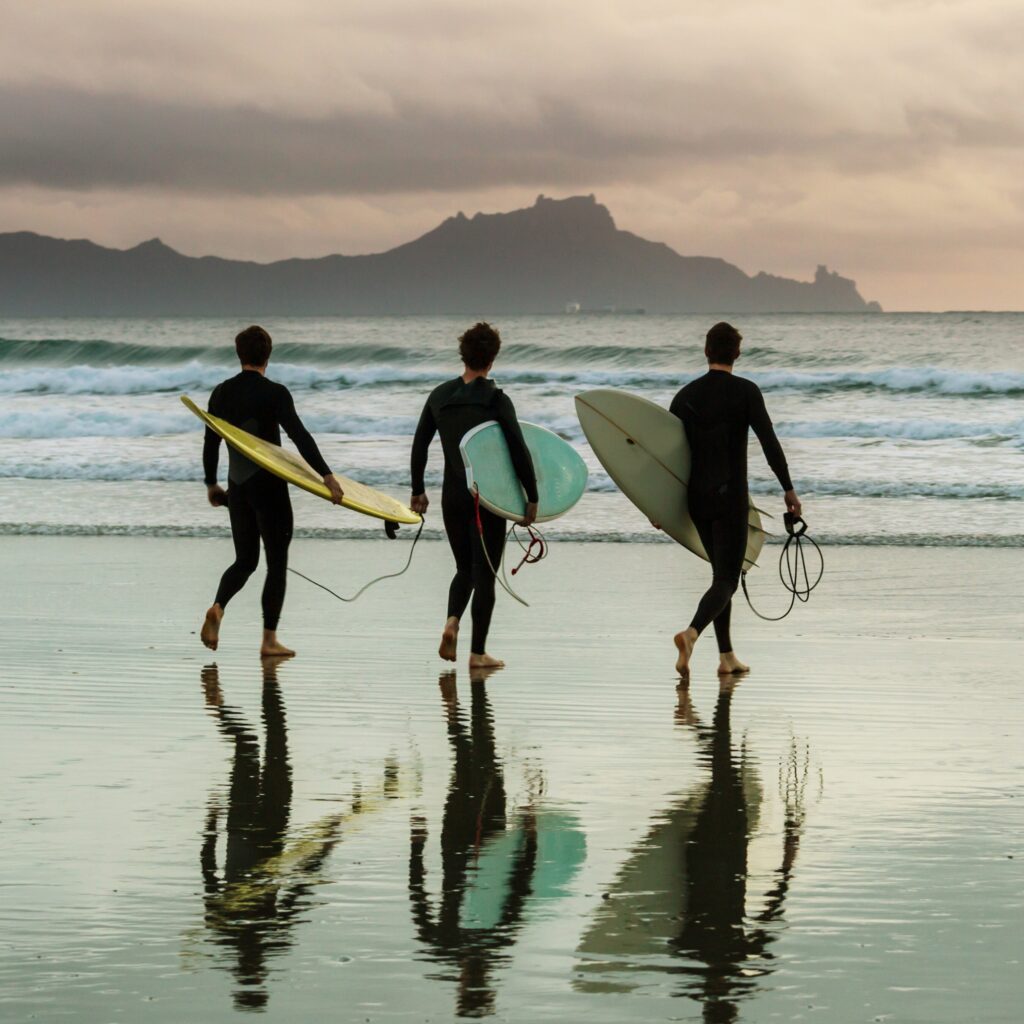
Surfing nurtures mental well-being. The deep concentration required to observe wave patterns, maintain balance, and respond in real time draws your mind away from daily distractions. The ocean’s steady rhythm has a naturally calming effect, creating space for presence and self-awareness. Over time, this immersive focus can reduce anxiety, ease mental tension, and help restore emotional balance.
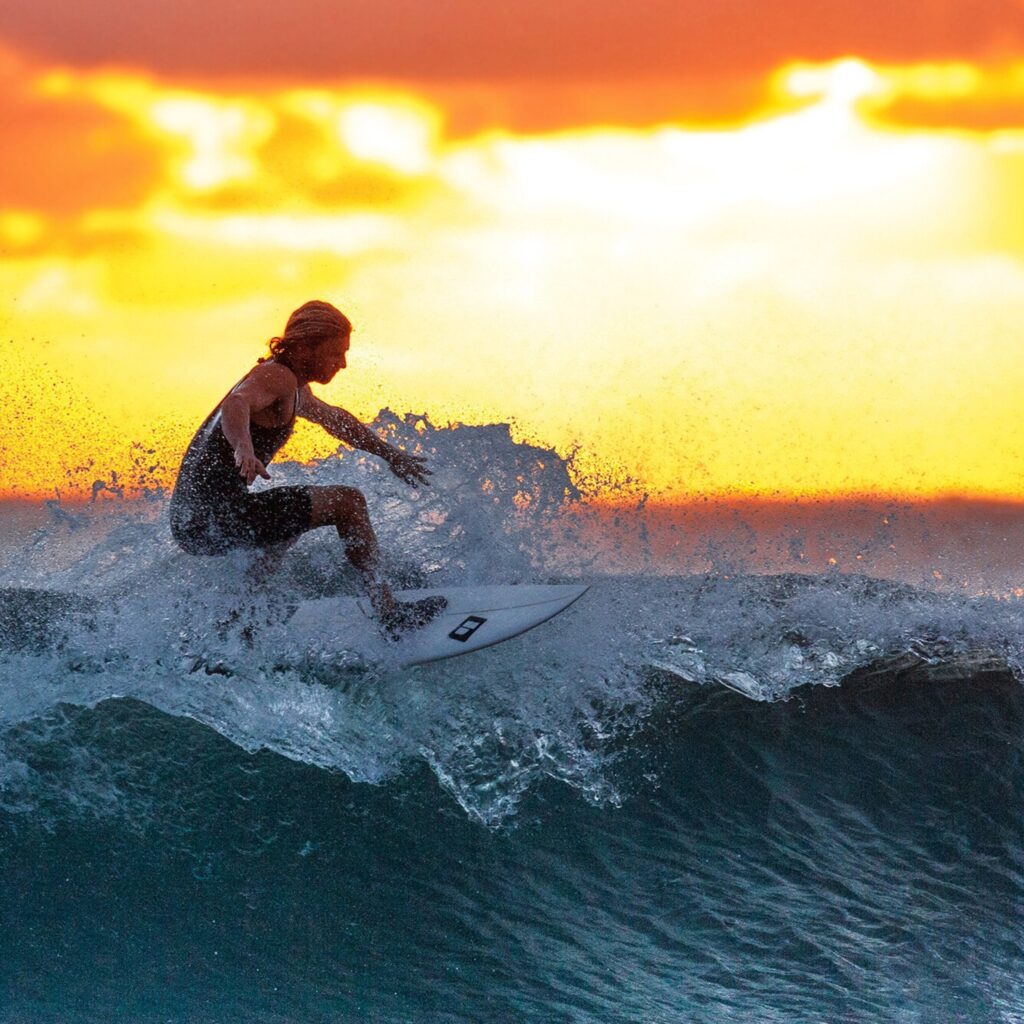
Spending time in the ocean enhances mood and mental clarity, thanks to a combination of natural elements and physical exertion. Exposure to sunlight supports vitamin D production and circadian rhythm regulation, while movement in saltwater helps improve circulation and release endorphins.
Whether you’re enjoying the calm between sets or the exhilaration of catching a wave, surfing often leads to a noticeable emotional lift and sense of freedom.
Surfing connects you with nature. Immersed in the vastness of the ocean, you become attuned to tides, weather, and the pulse of the sea. The physical sensations—salty spray, sun-warmed skin, the tug of a current—offer a full sensory experience that grounds you in the present moment. Surfing invites you to step away from screens and schedules, and into a rhythm that’s both humbling and deeply invigorating.
Getting Started
If you’re new to surfing, taking a lesson from a professional instructor can make a big difference. An experienced teacher will guide you the fundamentals, like paddling efficiently, choosing the right wave, proper board positioning, and how to pop up into a standing position.
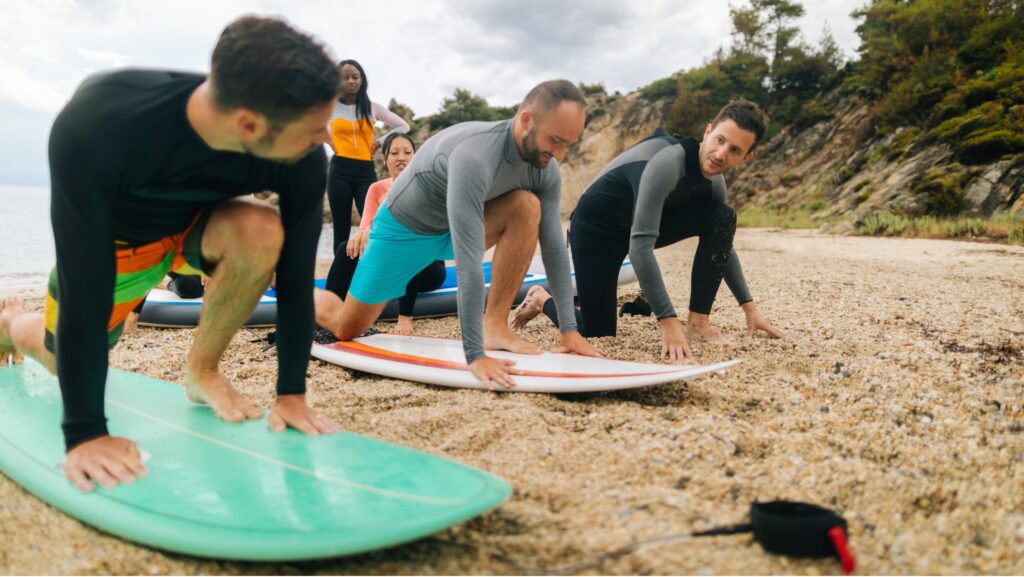
Just as importantly, they’ll introduce you to ocean safety basics, such as reading wave sets, navigating rip currents, and understanding local conditions.
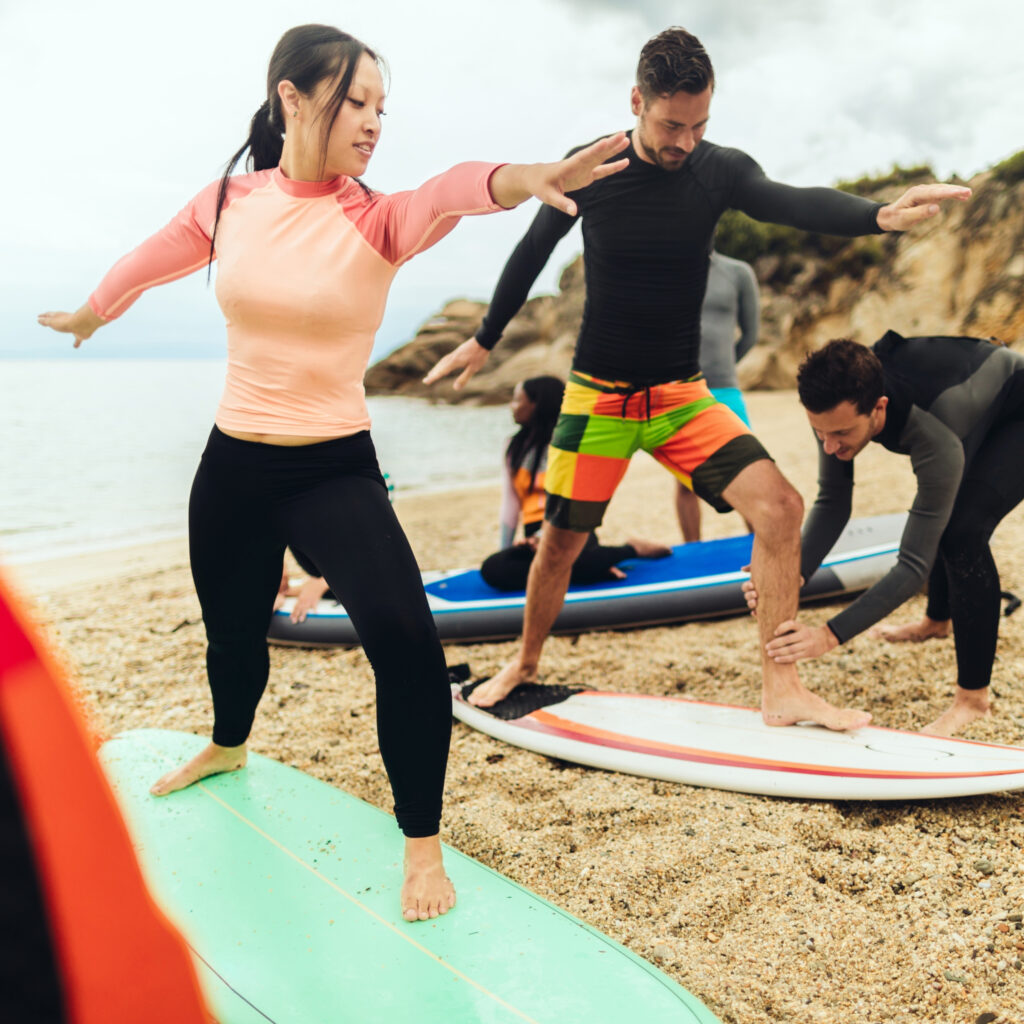
Starting with expert guidance builds a solid foundation and boosts your confidence in the water.
Before hitting the water, spend time on dry land practicing your pop-up technique. Lying on your board and quickly moving into a standing position is a key skill that becomes easier with repetition.
Practicing this movement on the beach or even at home helps develop muscle memory and improves balance and reaction time.
Once in the water, remember that progress comes gradually, focus on learning, not mastering, and celebrate each small win. Even if you don’t catch many waves, you’re learning every time you paddle out.
Start in small, beginner-friendly waves at a sandy-bottom beach with gentle breaks. These spots are ideal for learning the basics without the pressure of larger, more powerful waves.
Before heading out, check the surf forecast for wave size, wind conditions, and tide changes. Surf apps and local surf reports are great tools to help you plan wisely.
Choosing the right equipment is also key. A soft-top surfboard is perfect for beginners, offering extra stability and a more forgiving surface when falls happen.
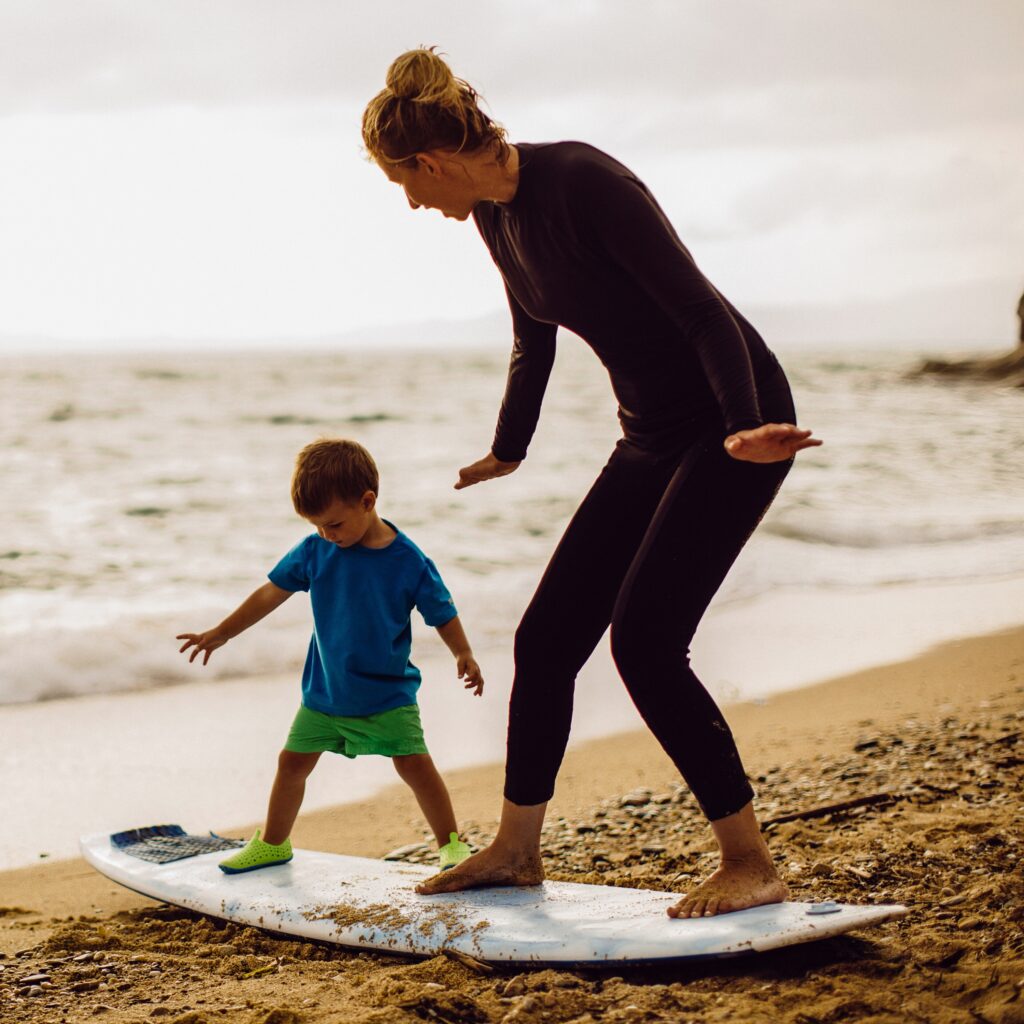
If the water’s chilly, a wetsuit will keep you comfortable and allow for longer sessions. Rash guards are also useful to prevent skin irritation from the board.

Since surfing involves a lot of paddling, building paddling strength is a smart move.Strengthening your shoulders, arms, and core through swimming, resistance training, or even dry paddling drills can enhance your endurance and performance on the board.
Surfing teaches you to be present and adaptable. Be mindful and aware in the water, it helps you improve faster. Watch other surfers, learn to read wave patterns, and stay mentally engaged with your environment, it is just as important as physical skill.
It’s important to learn how the ocean moves. Understanding how tides affect waves and how to spot dangerous currents will make you a more informed and confident surfer. Many instructors and online resources offer beginner-friendly lessons on ocean dynamics.
Understanding surf etiquette is just as important as learning technique. This includes waiting your turn, not “dropping in” on someone else’s wave, paddling out without blocking a rider’s path, and communicating clearly with other surfers.
Following this code of conduct not only keeps you safer but also earn you respect from more experienced surfers.
These shared norms aren’t just about courtesy, they help create a flow in the water where everyone can enjoy the experience without conflict or confusion.
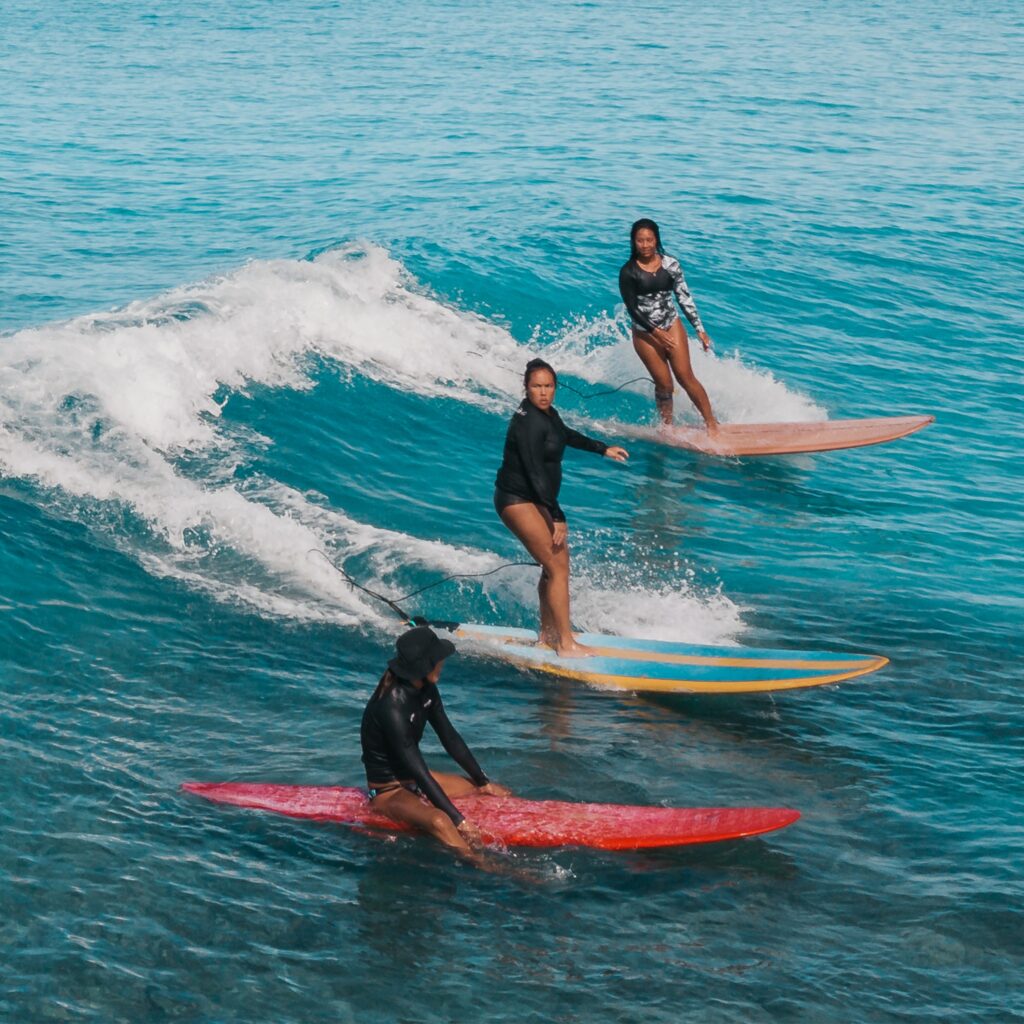
Respect the ocean and its ecosystems. Always leave the beach cleaner than you found it, avoid stepping on coral or disturbing wildlife, and follow local guidelines to help preserve the environment. Surfing is about connection—honoring the sea is a natural part of the experience.
Resources
Local surf schools and instructors are excellent for beginners and even intermediate surfers looking to refine their technique. They can teach proper form, paddling techniques, and how to “pop up” on your board, all while ensuring you understand ocean safety, wave dynamics, and surf etiquette. A few lessons can dramatically boost your confidence and accelerate your progress.
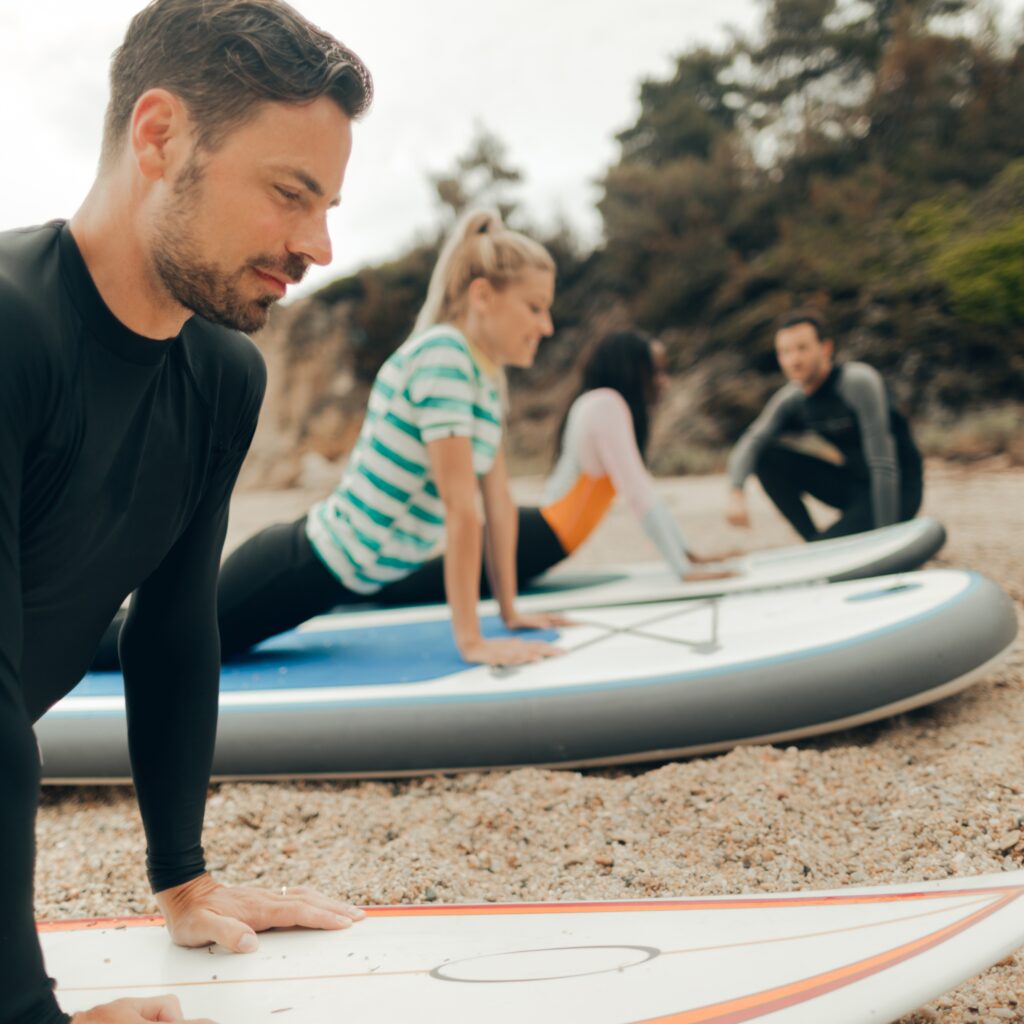
Online surfing tutorials, videos, and blogs provide accessible, visual learning that you can review at your own pace. From pop-up drills to wave reading strategies, these resources are a helpful supplement to in-person instruction or solo practice. Many seasoned surfers share insights and tips through YouTube channels, blog posts, and step-by-step guides.
Surf forums, social media groups, and mobile apps are great for connecting with the broader surfing community. Platforms like Surfline and Magicseaweed offer real-time surf forecasts, tide schedules, wind conditions, and safety alerts.
Forums and groups often share tips, surf spot updates, and gear recommendations, making them useful for both new and experienced surfers.
Local surf shops are more than retail spaces, they’re often run by experienced surfers who can give tailored advice, recommend beginner-friendly surf breaks, and help with board repairs.
Many also offer gear rentals, surf reports, and community event info, making them a hub for local surf culture.
Surfboard and wetsuit rentals are available at most surf shops or directly on many popular beaches. Renting allows you to try different board sizes and styles before committing to a purchase. Soft-top boards are typically recommended for beginners due to their stability and safety.
If you’re ready to invest in your own gear, start with a visit to a local surf shop where you can receive personalized fitting and hands-on guidance.

If shopping online, look for specialty retailers that offer detailed sizing charts, customer reviews, and expert support. Many online surf stores also carry accessories like leashes, wax, rash guards, and board bags.
Books and magazines about surfing can deepen your connection to the sport by exploring surf history, culture, technique, and inspiring stories from legendary surfers. Whether it’s a how-to manual or a memoir about life on the waves, reading about surfing can fuel your passion and keep you motivated between sessions.
Safety Tips
Safety should always be a top priority when heading out on the water. Always surf with a buddy or in a group. Having someone nearby can make all the difference in case of a wipeout, injury, or unexpected current.

Surfing with others also enhances safety by providing an extra set of eyes on conditions and fostering mutual support in the water.
Check the surf report and tide schedule before heading out. Websites and apps provide real-time data on swell size, direction, wind conditions, and tide changes.
Being informed ensures you’re prepared for the current conditions and helps you choose the right time and place to surf safely.
Stay aware of your surroundings at all times. The ocean is dynamic and conditions can change quickly. Always keep an eye out for other surfers, swimmers, boats, rocks, reefs, and sudden changes in wave size or current strength. Situational awareness helps prevent collisions, injuries, and getting caught off guard.
Wear sunscreen with broad-spectrum SPF protection, and opt for reef-safe formulas if you’re surfing in eco-sensitive areas.
Apply 15–30 minutes before entering the water and reapply frequently, especially after long sessions.
Staying hydrated before and after your surf is just as important to avoid fatigue, dehydration, and heat-related illness.
Know the local hazards. If you’re surfing in areas with strong currents, reef breaks, or large waves, take a lesson or go with someone who knows the spot.
Understanding the unique risks of each beach, like where the riptides form or how the tide impacts the surf zone, can help prevent accidents.

Use the proper gear for your conditions and skill level. A leash keeps your board tethered to you, reducing the risk of losing it or it becoming a hazard to others.
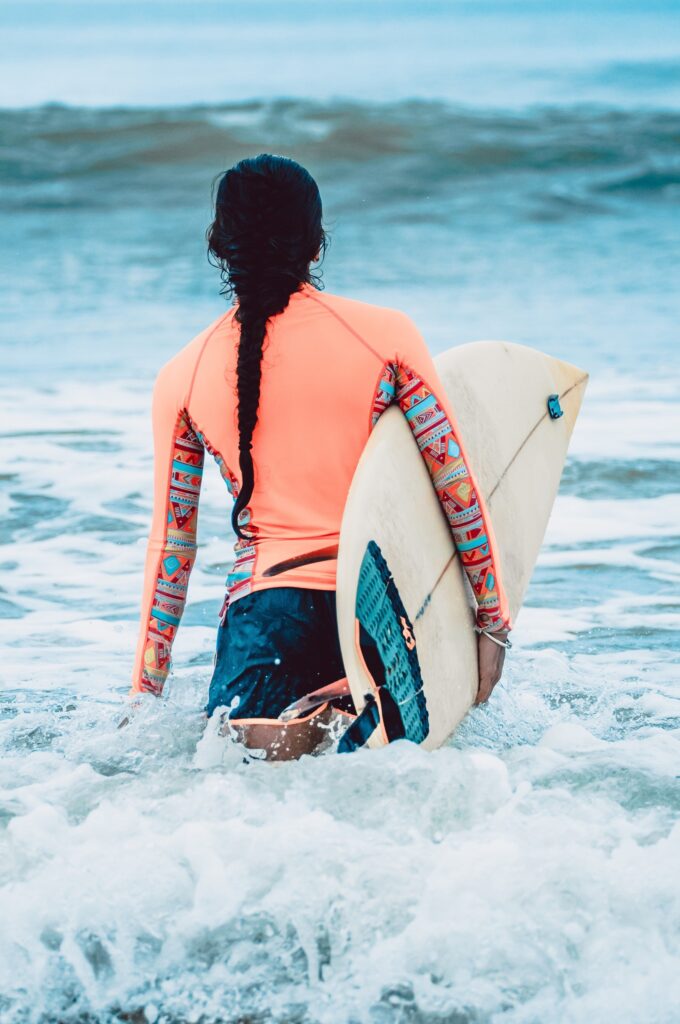
A wetsuit provides insulation in colder water and helps with buoyancy, comfort, and protection from scrapes or stings.
Don’t forget wax for grip and rash guards if you’re surfing without a wetsuit.
Know your limits and listen to your body. Surfing in conditions beyond your skill level can lead to injury or dangerous situations.
It’s perfectly fine to sit out a session, move to smaller waves, or take a break if you’re feeling tired or uncertain.
Progress comes with time, and your safety is always the priority.
Respect surf etiquette to help ensure everyone has a safe and positive experience in the lineup. This includes waiting your turn, not “dropping in” on someone else’s wave, paddling wide when returning to the break, and communicating clearly with other surfers. Surf etiquette isn’t just about courtesy, it’s essential for avoiding accidents and maintaining harmony in the water.

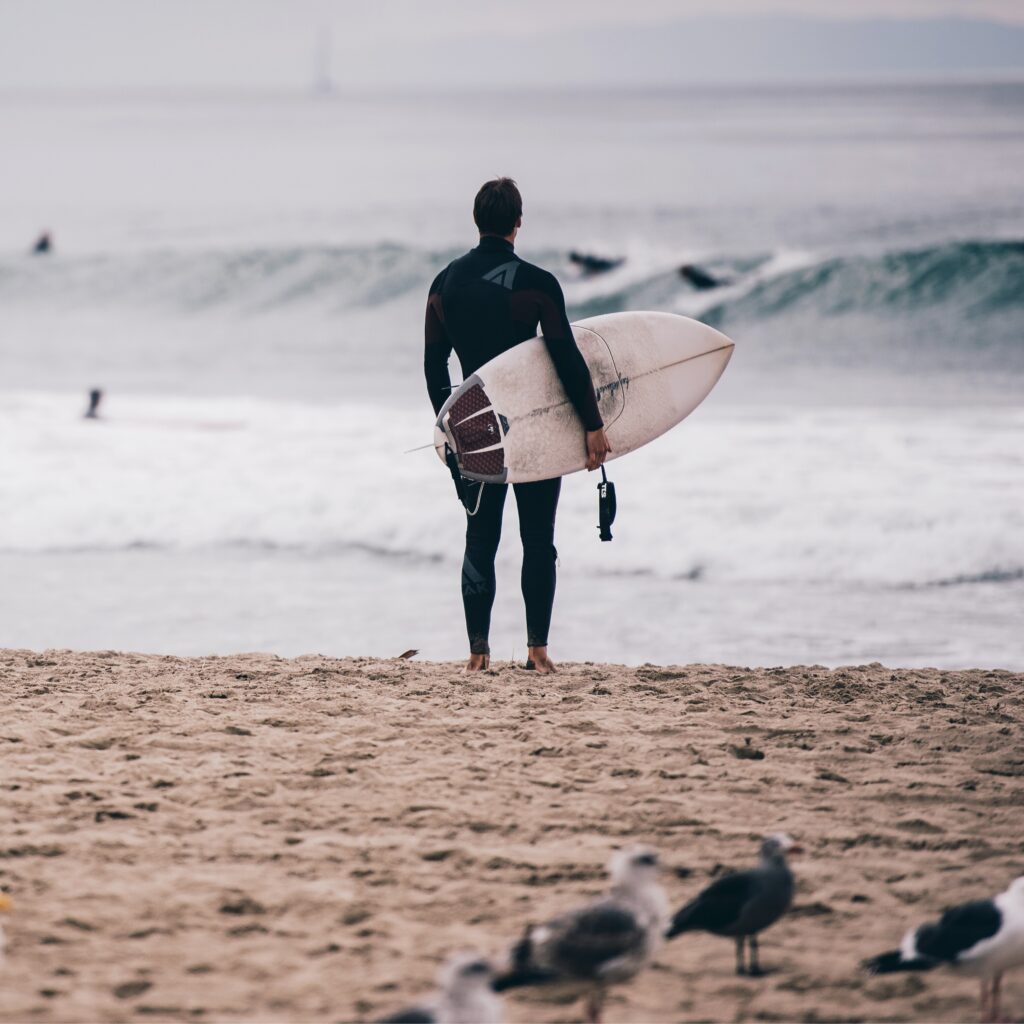

Final Thoughts
Surfing is more than just a sport, it’s a lifestyle, a mindset, and a powerful connection to nature. It challenges you to grow, teaches you to flow with change, and invites you to find joy in every ride. Whether you’re paddling out for the first time or chasing your next big wave, each session brings a new adventure. So grab your board, feel the energy of the ocean, and let the waves carry you someplace unforgettable.

Have you ever been surfing? What’s your favorite beach to catch some waves? Share your stories in the comments below!
Leave a Reply